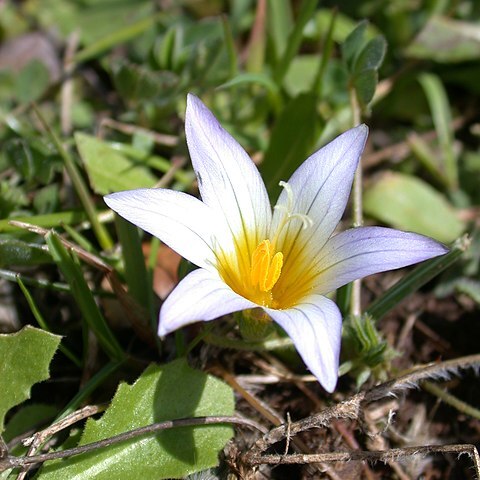Herbs, perennial, from corms. Stems: true stem aerial [subterranean and only peduncles of individual flowers aerial], simple or branched. Leaves 1–several; blade linear, oval to terete in cross section, 4-grooved (2 on each surface, on either side of thickened midrib) [2-grooved]. Inflorescences solitary flowers, interpreted as sessile, thus without pedicels; bracts inserted at ovary base, green or flushed with purple, unequal, outer exceeding inner, firm, inner bract margins membranous to scarious (rarely entirely scarious). Flowers odorless [fragrant], actinomorphic; tepals forming wide cup, connate into tube, subequal, outer whorl often slightly larger than inner; perianth tube funnel-shaped [or cylindric]; stamens symmetrical; filaments distinct [connate]; anthers usually erect, contiguous; style branching opposite or beyond anthers into 3 slender branches divided for ± 1/2 length. Capsules ovoid-oblong, walls firm, cartilaginous. Seeds many, globose; seed coat light to dark brown, often smooth, shiny. x = 13 or 14.
Small perennial herbs with annual leaves and flowers. Corm globose to bell-shaped; tunic hard, smooth. Leaves few, basal, filiform, terete, flat or compressed in section; rarely 1 or 2 leaves cauline on a short stem. Scape 1 to several, shorter than leaves, 1-flowered. Bracts 2, entire, acute, enclosing ovary, inner one often scarious or with hyaline margins. Flower erect, actinomorphic. Perianth tube short, narrowly funnel-shaped; lobes equal, spreading, narrowly elliptic to obovate. Stamens free, equilateral; anthers linear, basifixed, connivent, included. Style branches deeply bifid, filiform, emerging above or between stamens. Capsule oblong to ovoid, partly enclosed by spathes. Seeds numerous, compressed-globose, brown. [See also Green (1994: 518).]
Summer-green perennial. Corm small; tunic hard, woody, brown, usually smooth. Stem often not protruding above ground or else hidden by sheathing leaf-bases, occasionally elongate. Leaves few, much > stems, channelled, filiform, terete or compressed-cylindrical. Scape 1-several, emerging successively. Flower solitary, terminal, actinomorphic, often brightly coloured, usually funnel-shaped, within 2 spathe-valves; tube usually very short; lobes usually equal, ± spreading. Stamens symmetrical. Style-branches 3, usually deeply bifid. Capsule shortly cylindrical or ellipsoid, coriaceous. Seeds numerous, globose or angled. Spp. c. 90 mainly of S. Africa but also from Europe and tropical Africa. Adventive sp. 1.
Leaves few to several, the lower 2–3 entirely sheathing (cataphylls), green, membranous or firm; foliage leaves basal, 1-several, more or less filiform with the margins and raised midribs often transversely winged, the blade thus terete with 4 longitudinal grooves, occasionally the leaves nearly plane with margins and midrib slightly thickened or only the margins thickened and winged.
Flowers actinomorphic, cupulate (hypocrateriform in a few South African species), variously coloured, often yellow in the centre; tepals united in a short to long perianth tube, subequal, usually spreading above.
Flowers solitary and terminal, sessile, subtended by 2 opposed bracts; floral bracts green, often the margins membranous and pale or ferrugineous, occasionally the inner bract entirely dry.
Ovary globose, style dividing at or above the level of the anthers; style branches short, usually divided for half their length.
Stamens symmetrically disposed; filaments erect, more or less contiguous, sometimes united; anthers diverging or contiguous.
Stem short, aerial, or subterranean and becoming aerial in fruiting plants, simple or branching above or below the ground.
Perennial herbs with small globose corms, aerial parts dying back annually; corms with woody to firm membranous tunics.
Seeds many per locule, more or less globose or lightly angled, hard, glossy or matt.
Capsules oblong.

